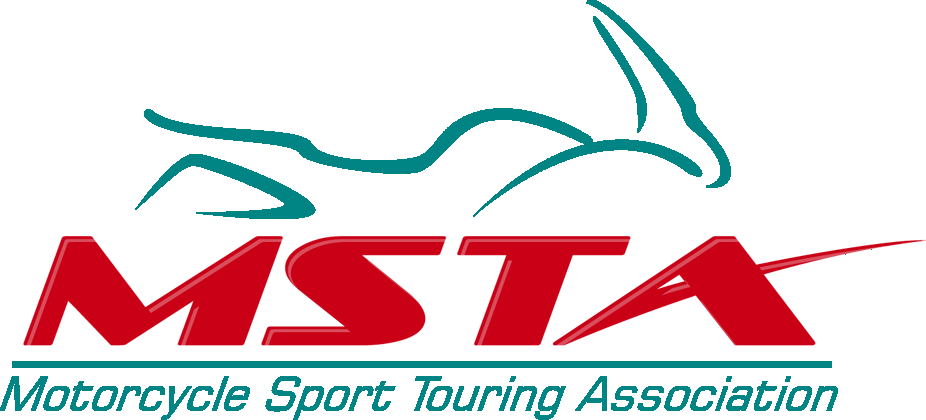These articles were written by our current president, Norm Kern, several years ago. They tell of his journey from a young kid in the late 1950’s through his early adult life in the 1960’s and how 2-wheeled transportation has played a part in almost everything in his life. I hope you enjoy them as much as I have…Patrick M.
Last time I got my feet (and rest of my body too) wet on an ill-fated honeymoon trip on my 1962 BMW R69. I knew that I needed a bigger, more powerful bike for two-up touring. I knew BMW was coming out with an all-new 750 in fall 1969 and I was waiting for it.
The phone rang on a Saturday morning in June. It was the Aultz. “I just got the new issue of Cycle World and the new 750 BMW is on the cover!” “What do you think?” I said. Aultz was sort of upset. “It’s UGLY. The motor looks like a big tadpole and the Honda 450 gas tank hump is back.” I rode down to Cincinnati to look at the magazine and he was right. I also saw the spindly tubing that formed the rear frame section, held on by four 6mm bolts. The rear frame on my wobbly old R69 looked stronger than the new one. The final deal breaker was the price. The old series BMWs had been selling for about $1600. The new one was over $2400. That was a lot of money for a motorcycle in 1969.
“What are you going to do?” I asked The Aultz. “I’m going to look at one of these,” he said, turning to a two-page ad for the new Moto Guzzi 750 Ambassador. I had seen the earlier 700cc model before. It had a homely shaped red tank, side float Dellorto carbs, and it was Italian, which meant unreliable. The Ambassador cast the big V-twin in a new light. It was all black with white pinstripes like my R69. The new six-gallon tank was beautifully shaped. Modern concentric Dellorto carbs with accelerator pumps had replaced the old side float type. Shaft drive, 300-watt generator, 32AH battery, comfortable looking seat, solid frame designed for touring with luggage and priced at about $1800. The 90-degree V twin motor was very smooth for a twin and made about 60 HP. With the cylinders sticking out the sides of the bike it ran cool and had good cornering clearance for such a big bike. Cycle magazine tested the Moto Guzzi. They called it elephantine (it weighed a little over 600 pounds) but loved it. Bob Schantz of Sport motors took me for a ride on one and I was sold. The Aultz and I each bought one in December of 1969.
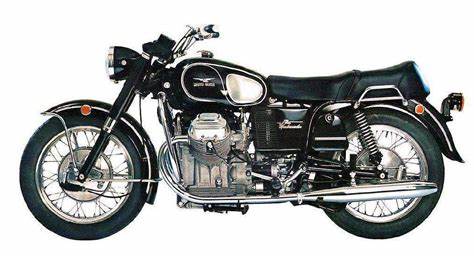
During the winter, I fitted my Guzzi with a Wixom Brothers handlebar mount fairing. For luggage I devised an elaborate rack made from stainless steel strap. A loop from the rear of the seat supported a fiberglass trunk. A rectangular frame supported four hooked arms designed to hold two large duffel bags on each side. The bags carried all our clothing and most of our gear. The tent and sleeping bags strapped on top of the trunk. Plastic trashcan liners inside the bags kept things dry in the event of rain. Not elegant, but practical. This setup gave us huge luggage capacity for long trips. Fortunately, the big Guzzi had the power and solid handing to carry this enormous load. At Easter, we did a shakedown trip to St. Petersburg, Florida. Two days down, three days there, two days back. Everything worked great. When we got back, we started making plans for our first big trip- the last two weeks in June to Colorado, Utah, and Arizona.
We wanted to spend as much time out west as possible, so we left after work on a Thursday night, rode till dusk, and camped at Effingham, IL. The next day we rode across Illinois, Missouri, and into the winds of Kansas. We had open face helmets with flip up shields, and the wind flipped mine up regularly. My wife had to reach around and hold it down at times. The wind blew so hard that I had to run flat out in third gear to maintain 70 MPH. At one point I went on reserve just after an exit, so I turned around at the next one to go back. Now riding with a tailwind, I put my hand out and accelerated to see when the air was still. 45MPH! It was a rough day, but we made it all the way to Goodland, Kansas. We passed through Denver at noon on Saturday and camped in the mountains that night.
I had always wanted to see a ghost town, so the next morning we started out with some sketchy instructions to find one. We headed up a mountain on a narrow road that turned to gravel, then dirt. We kept going, hoping to find the ghost town. Clouds blew in and we hit fog and some flurries. Before long, we found ourselves at a mountain pass, so we decided to continue down the other side rather than try to go back. We eventually came out to a paved road. Although we never found the ghost town, we had crossed the continental divide on a dirt road! (Guanella Pass) We worked our way across central Colorado, stopping in Aspen. There were very few people touring the country on motorcycles in 1970. Wherever we stopped, especially in small towns, we drew a crowd. People wanted to meet us, look at the bike, etc. At nearly every gas station was old-timer who “had a Harley once.” Speaking of Harleys, even out-of-the-way places often had a small Harley shop. Bigger towns might have a Triumph or other Brit bike shop as well. Japanese dealers were only in the larger cities and Moto Guzzi dealers were non-existent. I did not meet a single person on the trip who had ever seen a Moto Guzzi before.
This was the year that Honda came out with their first big bike, the CB750 four.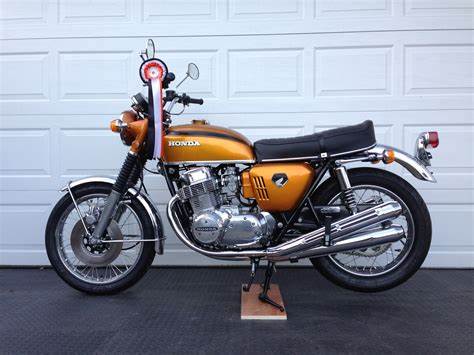 I saw a few of them on the road, including one at the side of the road with the rider holding his chain in his hand. Today, we take chain reliability for granted, but in 1970 they were no match for the power of a 750 Honda. To try to improve reliability, the CB750 chain had no master link. You replaced the chain by removing the swing arm. These problems, combined with an uncomfortable seat and weak suspension made the big Honda less desirable for touring.
I saw a few of them on the road, including one at the side of the road with the rider holding his chain in his hand. Today, we take chain reliability for granted, but in 1970 they were no match for the power of a 750 Honda. To try to improve reliability, the CB750 chain had no master link. You replaced the chain by removing the swing arm. These problems, combined with an uncomfortable seat and weak suspension made the big Honda less desirable for touring.
When we crossed into Utah, we took a back road from I70 through the mountains into Moab. The road was practically deserted, so we could stop anywhere, take pictures and drink in the natural beauty. It struck me how great it was to be seeing all these things from the seat of a bike rather than through the frame of a car window. After touring Arches National Park the next morning, we headed west on I70 through Green River and down RT24. About five miles down the road, we encountered a state trooper standing by his cruiser, motioning for us to stop. He told us to turn off the motor. I asked if we were in trouble. He said no, that we just needed to wait awhile. They were shooting a movie down the road and were doing a scene with a naked girl on a motorcycle. I thought, “Yeah, right! This guy is pulling my leg.” He didn’t know the name of the movie but said it was a car chase film being made with British money. I didn’t find out until later that the movie was Vanishing Point, starring Barry Newman and Cleavon Little.
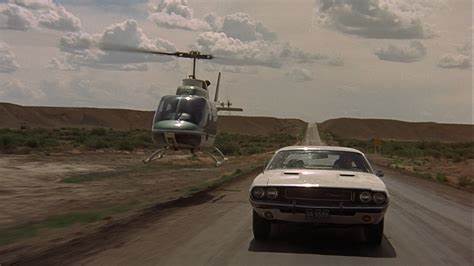
After we waited about ten minutes, a white car came toward us. On the front was a camera rig with a big xenon light simulating sunlight on the driver. Behind the car was a very low trailer full of batteries to run the lights. The right door had been removed. Barry Newman was driving and Richard Sarafian, the director, was in the back seat. The camera operator, an enormous hippie type, was crouched in the passenger seat. When he turned around, Barry Newman got stuck in the sand at the side of the road. The cop tried to tow him out but needed more help. He recruited several of us who were waiting, and we helped push the car back on the road. Barry Newman did not know squat about driving on sand, even though there is a lot of desert driving in the movie.
About twenty minutes after they left, the cop waved us on. We came upon the location where they were shooting about five miles down the road. People and equipment were everywhere. Later when I saw Vanishing Point at the theater, I recognized the location where a naked girl really does ride up on a motorcycle.
We continued down RT 24 to reach the Boulder-Escalante-Panguich highway, a scenic road through the mountains that ends near Bryce Canyon. We rode through groves of Aspen trees as we headed into the mountains. Soon the road turned to gravel, then dirt with big rocks. A lot of it was first and second gear. I was afraid we may break down and never be found or that the rough road would go all the way to Panguich, but the pavement returned as soon as we got to Escalante. In 1990, my wife and I traveled back through Utah over the same highway. I hardly recognized it- fully paved, cleared land, mature small towns, but no challenge or adventure. Over the next few days, we toured Bryce Canyon and Zion National Park. The weather so far had been absolutely perfect- blue skies with puffy white clouds, warm during the day, chilly at night, never a threat of rain.
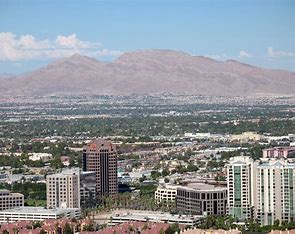
We were in for shock as we came out of the mountains of Zion. There is a long grade that descends gradually toward Las Vegas. As the altitude drops, the temperature rises. It became very hot and dry. We camped for the night at Lake Mead. It was a great challenge to drive the tent stakes into the ground, which was like concrete. I broke one of them the next morning trying to pull it out of the ground. It’s probably still there. We rode through Las Vegas and stopped to tour Hoover Dam. Next stop is the south rim of Grand Canyon.
What we learned this time:
1. Motorcycle touring is fabulous when you have the right bike and gear.
2. The wind in Kansas is as bad as everyone says.
3. Perfect weather makes long miles shorter.
4. Meeting people is fun and easy when they want to meet YOU.
5. Back roads are where you find fun and adventure.
6. Having dealers nearby isn’t important when your bike is trouble free.
Is this trip good too be true? Next time, our trip makes an abrupt turn into the Twilight Zone as we are faced with one challenge after another. Find out how we survived in Kickstart VI.
